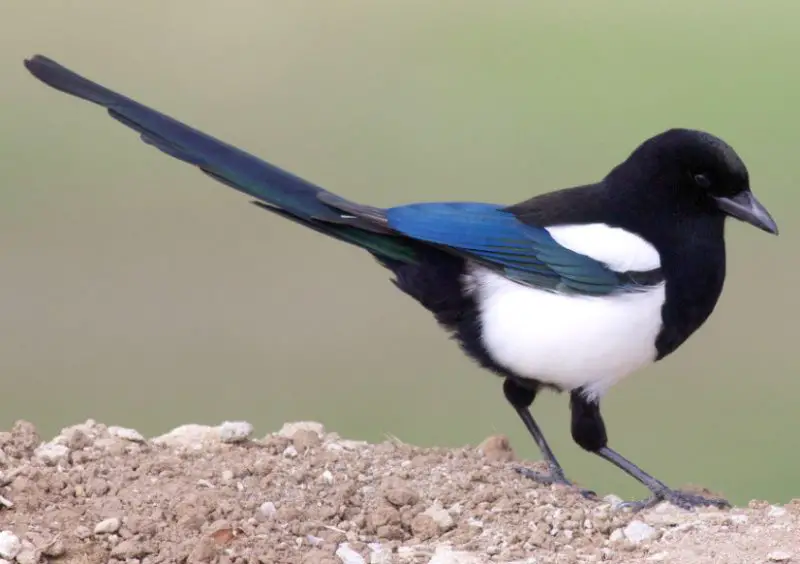If you’ve ever noticed a striking black and white bird with a long tail swooping across Colorado’s open fields or perched boldly on a fencepost, you’ve likely spotted the Black-billed Magpie (Pica hudsonia). This intelligent and charismatic bird is one of Colorado’s most recognizable species, admired by birdwatchers and nature enthusiasts alike.
With its glossy black plumage, crisp white markings, and remarkable tail that glimmers with iridescent hues in the sunlight, the Black-billed Magpie stands out in any setting. It’s a year-round resident across the state, from grasslands and foothills to suburban neighborhoods and rural farmlands.
In this comprehensive guide, you’ll learn how to identify this black and white bird with a long tail in Colorado, where to find it, how to distinguish it from similar species, and what makes its behavior so fascinating. Let’s dive in.
Appearance and Identification

Striking Color Contrast
The Black-billed Magpie is instantly recognizable due to its sharp contrast of black and white plumage. Its head, chest, and back are a rich glossy black that shines with a greenish-blue iridescence under sunlight. The belly and shoulder patches are bright white, creating a bold, unmistakable pattern.
When the magpie spreads its wings, you’ll see flashes of white that stand out vividly against the black feathers. The long tail—often as long as the bird’s entire body—shimmers with blue, green, and violet tones. This iridescence makes the magpie particularly photogenic and easy to spot even from a distance.
Long Tail and Elegant Posture
Tail length is one of the most defining features of the magpie. Measuring nearly half of the bird’s total body length, the tail often fans out in flight or droops gracefully when perched. This feature is the key reason most people describe it as “a black and white bird with a long tail.”
In flight, the tail helps with balance and maneuverability, allowing the magpie to glide effortlessly through open areas or weave through trees with agility.
Size and Shape
The Black-billed Magpie is a medium-sized bird, larger than a jay but smaller than a crow. Adults typically measure 17 to 23 inches in total length, including the long tail, and have a wingspan of 22 to 24 inches. Their sturdy black bill and legs complete the sleek appearance, emphasizing their corvid lineage.
Habitat and Distribution in Colorado
Year-Round Resident
Unlike migratory songbirds, the Black-billed Magpie is a permanent resident in Colorado. You can find it throughout the year in almost every region of the state, from the eastern plains to the foothills of the Rockies.
It prefers open habitats—grasslands, rangelands, and riparian areas—but adapts remarkably well to human presence. You’ll often see them along rural roads, near farms, or perched in suburban neighborhoods where food sources are abundant.
Altitude Range
Magpies inhabit elevations ranging from lowland plains to over 10,000 feet in summer months. During winter, they may move slightly downslope, seeking milder conditions. Their adaptability to varying altitudes helps explain their wide distribution across Colorado.
Common Sightings
If you’re birding in Rocky Mountain National Park, the San Luis Valley, or even Denver’s outskirts, chances are good you’ll encounter a magpie. They are highly visible, rarely shy, and often curious about humans. Their loud calls often give away their presence before you even spot them.
Behavior and Feeding Habits
Opportunistic Forager
The Black-billed Magpie is an omnivore, meaning it eats both plant and animal matter. Its diet includes insects, small rodents, berries, fruits, seeds, and carrion. In rural areas, they’re frequently seen feeding on roadkill or scavenging near trash bins—proof of their intelligence and adaptability.
They also display interesting symbiotic behavior: magpies have been observed picking ticks off large mammals such as deer and livestock, benefiting both parties.
Highly Intelligent
As a member of the corvid family, magpies share their intelligence with crows and ravens. They have complex social structures, problem-solving abilities, and even the capacity for self-recognition—a rare trait in animals. Watching a magpie interact with its surroundings offers insight into the bird’s remarkable cognition.
Social Nature
Magpies are gregarious birds. During the breeding season, they live in pairs, but outside of it, they form flocks that can number dozens. They communicate through a variety of calls—harsh chatters, scolding squawks, and softer warbles. Their vocal versatility reflects both intelligence and social bonding.
Breeding and Nesting
Nest Construction
Few birds build nests as elaborate as the magpie. The Black-billed Magpie creates a large, dome-shaped nest from sticks, twigs, and mud, often lined with soft grass and hair. These nests can reach up to three feet in diameter and are typically built in trees or tall shrubs.
The dome design includes an entrance hole on the side, providing shelter against predators and the elements. Both males and females participate in construction, which can take up to six weeks to complete.
Breeding Season
In Colorado, breeding begins in late March or early April. The female lays between six and nine eggs, which she incubates for about 18 days. The young fledge at around four weeks old but remain dependent on their parents for several weeks after.
Parental Care
Both parents share the duties of feeding and protecting their chicks. Magpie parents are fiercely territorial during this period, often chasing away other birds—or even humans—who come too close to their nests.
How to Identify It in the Field
Quick Field Marks
- Color Pattern: Glossy black head, back, and tail; white belly and shoulder patches.
- Tail Length: Exceptionally long—often longer than the bird’s body.
- Wings: Black with large white patches visible in flight.
- Bill and Legs: Both solid black.
- Behavior: Confident, noisy, and often foraging on the ground.
- Habitat: Open countryside, farmland, and suburban edges.
If the bird you’re observing fits these features, it’s almost certainly the Black-billed Magpie.
Behavior Cues
Magpies walk or hop confidently on the ground while searching for food. They perch openly on posts, branches, and fences, often calling loudly. During flight, you’ll see the striking white patches on the wings and the long, graceful tail trailing behind.
Look-Alike Birds in Colorado
While few birds resemble the Black-billed Magpie closely, some black and white species might cause brief confusion.
Northern Shrike (Lanius excubitor)
The Northern Shrike is a smaller black-and-white bird sometimes seen in Colorado during winter. It has a hooked beak and gray upperparts but lacks the magpie’s long tail and vivid iridescence.
Loggerhead Shrike (Lanius ludovicianus)
Similar in shape to the Northern Shrike but more compact, the Loggerhead Shrike has a black mask and shorter tail. It’s a bird of open country but lacks the bold white wing flashes of a magpie.
Horned Lark (Eremophila alpestris)
While also found in open Colorado fields, Horned Larks are smaller with brown and white plumage and short tails—very different once seen up close.
In short, no other Colorado bird combines black-and-white coloration, large size, and an exceptionally long tail quite like the Black-billed Magpie.
Habitat Preferences and Range in Detail
Magpies favor open landscapes with scattered trees or shrubs, avoiding dense forests. They thrive in environments that provide both visibility and nesting sites. Typical habitats include:
- Grasslands and rangelands
- Farmlands and pastures
- River valleys with cottonwoods
- Foothills and low mountain meadows
- Suburban areas with open lawns and tall trees
In Colorado’s ecosystems, they serve an important ecological role by consuming carrion and insects, helping maintain environmental balance.
Conservation and Human Interaction
Population Status
The Black-billed Magpie is listed as a species of Least Concern by the IUCN due to its wide distribution and stable population. In Colorado, it remains common and widespread, adapting well even to human-altered environments.
Benefits to Humans
Despite occasionally raiding crops or scavenging in trash, magpies provide ecological benefits by controlling pest insects and cleaning up carrion. Many farmers now view them as allies rather than nuisances.
Potential Threats
Localized declines can occur due to habitat loss, reduced carrion availability, and secondary poisoning from rodenticides. Public awareness and proper pest management can mitigate these risks.
Tips for Observing and Photographing
Best Time of Day
Magpies are active throughout the day, but early mornings and late afternoons offer the best light for observing their iridescent feathers.
Locations to Visit
You can spot them easily in areas like:
- Rocky Mountain National Park
- Boulder County open spaces
- Pueblo Reservoir
- Colorado Springs foothills
- Eastern plains near Fort Collins
Photography Tips
To capture their colors, use natural sunlight from behind you. A fast shutter speed freezes their rapid movements, while a telephoto lens (200mm+) helps frame them without disturbing their natural behavior.
Behavior and Adaptations
Intelligence and Problem Solving
Black-billed Magpies have been known to use tools, mimic sounds, and even recognize themselves in mirrors. They hide food for later use and remember its location for weeks—demonstrating advanced memory.
Cooperative Social System
Outside the breeding season, they form flocks and roost together. Social cooperation helps them locate food and avoid predators.
Adaptation to Human Environments
Their comfort around humans shows impressive adaptability. From rural barns to suburban parks, magpies have learned that people indirectly provide food opportunities—through insects, roadkill, or waste.
Interesting Facts About Black-billed Magpies
- They are part of the crow family (Corvidae), which includes crows, ravens, and jays.
- Magpies can recognize individual human faces, a sign of advanced intelligence.
- Their nests are some of the largest among passerines in North America.
- In folklore, magpies are often associated with luck, curiosity, and communication.
- They play a vital ecological role as scavengers, keeping environments clean.
Tips for Attracting Magpies to Your Yard
While magpies are common, you can encourage them to visit your area by:
- Providing open space with perches or trees.
- Avoiding pesticides to keep their insect prey available.
- Leaving suet, fruit, or unsalted peanuts in open feeders.
- Offering a birdbath for drinking and bathing.
Remember that magpies are curious and may explore any shiny objects or food sources left outdoors.
FAQs About Black and White Bird With Long Tail in Colorado
What is the black and white bird with a long tail in Colorado?
It’s most likely the Black-billed Magpie, a year-round resident known for its striking plumage and long iridescent tail.
Are magpies friendly to humans?
They’re intelligent and bold but not typically aggressive. They may become defensive near nests during breeding season.
Do magpies migrate?
No, Black-billed Magpies are non-migratory and stay in Colorado throughout the year.
What do magpies eat?
Their diet includes insects, small animals, fruits, seeds, and carrion—making them important scavengers.
Can magpies mimic human sounds?
Yes, in captivity or near humans, they can imitate noises or words, similar to crows and ravens.
Final Thoughts
The Black-billed Magpie is one of Colorado’s most iconic birds. Its elegant black-and-white plumage, graceful long tail, and intelligent behavior make it a favorite among birdwatchers. Once you learn its key field marks—especially the long iridescent tail and bold wing patches—you’ll never mistake it for another species.
Whether you’re hiking through Colorado’s grasslands, driving along rural roads, or simply relaxing in your backyard, take a moment to appreciate this remarkable bird. The more you observe it, the more you’ll understand why the magpie continues to capture attention and admiration across the Centennial State.






